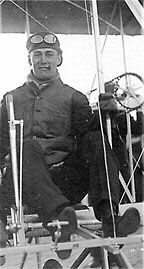WRIGHT
BROTHERS Aeroplane Company
![]()
![]()
![]()
![]()
| Cal
was brought up to push the limits. He was born to the prestigious Rodgers
and Perry clans, and could claim Commodores Matthew Calbraith Perry and
Oliver Hazard Perry as his ancestors. On his father's side, there was a
long list of admirals and vice admirals. The family boasted that there
had always been a Rodgers serving in the U.S. Navy since its inception.
Cal's mother Maria Chambers Rodgers Sweitzer described his ancestry as an
"aristocracy of heroes." Unfortunately, a childhood bout with
scarlet fever affected Cal's hearing, leaving him completely
deaf in one ear and severely impaired in the other. His
deafness, in turn, made him unfit for military
service. He seemed rudderless through most of his twenties, hunting for
gold in Africa and racing motorcycles and automobiles in the States. In
the spring of 1911, he traveled with his cousin Lieutenant John Rodgers to
Dayton, Ohio where the Navy had posted John while he learned to fly. Cal's
first sight of an aircraft at the Wright Flying School at old Huffman
Prairie seemed to transform him. Said his wife Mabel, "It was as if
the last piece of a jigsaw puzzle had slipped into place in his
mind."
Cal Rodgers determined to get into the air and reported to the Wright Flying School on June 5, 1911. Within a week, his instructor Al Welsh was letting him take-off, fly, and land the airplane. When he asked to be allowed a solo flight, Welsh balked � Cal didn't yet have enough experience. So Cal bought the training airplane � a Wright Model B � and on June 12 he made a wobbly take-off and a hard landing, but he made them alone as pilot-in-command. He continued to hone his flying skills at Huffman Prairie for the rest of June, and flew his first exhibition flights in July. On August 7, 1911 he took his official flying examination at Huffman Prairie and became the forty-ninth aviator licensed to fly by the FAI (Federation Aeronautique Internationale). Five days later, he was in Chicago for his first big air meet. He came in third in the prize money, winning over $11,000 for endurance flying. While he was there, he caught the eye of promoter Stewart DeKraft. Dekraft broached the idea of a transcontinental flight with Cal, the fledgling aviator agreed, and by September 5, DeKraft had secured Armour's sponsorship. On September 10, Cal purchased a Model EX from the Wright Company. Orville Wright gave his honest opinion of the endeavor at the sale. "There isn't a machine in existence that can be relied upon for 1,000 miles and here you want to go over 4,000. It will vibrate itself to death before you get to Chicago. But then," said Orville, referring to the EX's comparatively light weight, "six good men could carry it across the country." So � a little over three months after he had learned to fly, Cal Rodgers and the Vin Fiz were poised on a field in Long Island, pointed west toward the Pacific Ocean. When asked by a reporter why his transcontinental journey was so important, Cal replied, "It's important�because everything else I've done was unimportant." |
Click on a
photo to enlarge it.
Cal Rodgers at home in the cockpit of the Vin Fiz. He chain-smoked cigars, even as he flew.
|